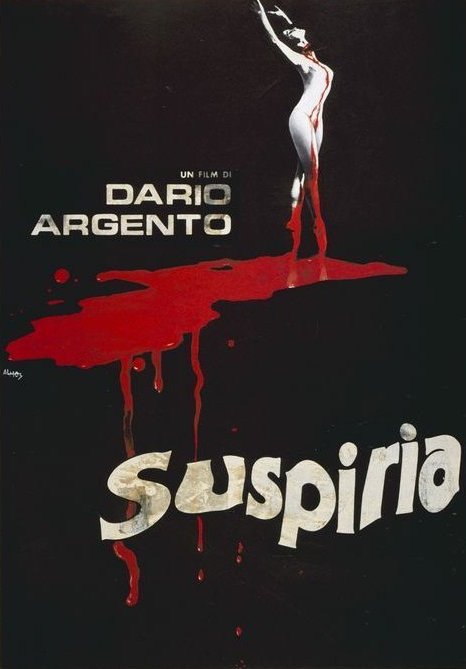
There are films that scream for a Blu-Ray release, and Dario Argento's horror masterpiece Suspiria is one of them. Cinematographer Luciano Tovoli shines in this film. His aspect ratio bending shots of the dance school coupled with garish lighting techniques that would make Fassbinder or Wong Kar-Wai blush makes each scene of this film it's own study guide. When I was doing the screencaps for this post, I kept asking myself "How in the hell did they do that...???", and I'm still wondering how one can light an impaled girl in ten different acid-tinged hues. But I'm not Dario Argento, now am I? Enjoy.

From Ed Gonzalez at Slant Magazine:
After the mostly international success of Deep Red, Dario Argento grew tired of making giallos. 1977's Suspiria, the first part of the director's unfinished Three Mothers trilogy, marked his first foray into the realm of the supernatural. Argento's deliriously artificial horror film owes as much to Georges Méliès and German Expressionism (specifically The Cabinet of Dr. Caligari) as it does to Jean Cocteau and Grimm fairy tales. Having traveled through many European capitals (including the geographical "magic" point where Switzerland, France, and Germany meet), Argento became entranced with the Austrian-born Rudolf Steiner, whose controversial Waldorf schools had been attacked for teaching occult practices in the guise of arts-based education.
Less real-world influences came from Argento's partner Daria Nicolodi, who had become attracted to various fairy-tale sources, from Alice in Wonderland and Bluebeard to Pinocchio and Snow White and the Seven Dwarfs. Argento's visuals actively evoke a fairy-tale fantastique, engaging and toying with the Technicolor glory of Disney's cartoon version of Snow White, a film the director had been obsessed with since youth. Additional elements were filtered into the project from Suspiria de Profundis (Sighs from the Depths), a collection of essays written by Thomas De Quincey (Confessions of an Opium Eater), and Fritz Lang's little-seen The Secret Beyond the Door, a Freudian interpretation of the Bluebeard story from which the Argento film borrows considerably more than the fabulous Joan Bennett.
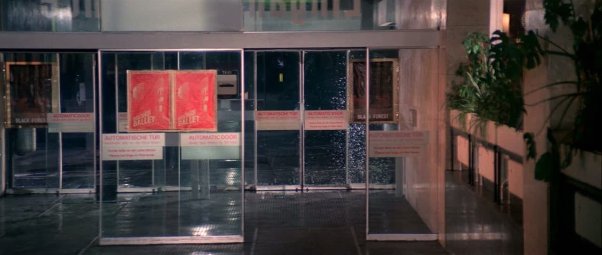
The delirious Goblin composition that accompanies the film's opening scene brings to mind the sounds of a little girl's ballerina music box. A narrator's voice is barely audible over the soundtrack, which plays atop the standard white-on-black credits: "Suzy Banyon decided to perfect her ballet studies in the most famous school of dance in Europe. She chose the celebrated Tanzakademie of Freiburg. One day at 9am, she left Kennedy airport, New York, and arrived in Germany at 10:40 local time." While there are few signifiers here to suggest the tale takes place in Germany, Argento subtly focuses the spectator's gaze on a poster of the Black Forest taped to one of the airport terminal's walls. Suspiria may be Argento's silliest work, but while its plot is scarcely sensible, the film rightfully earns its notoriety via Argento's fabulous and detailed engagement and reworking of fairy-tale motifs. The film's opening "once upon a time" giddily anticipates the nasty folktale that follows.
Suzy (Jessica Harper) arrives at the German airport. Like a ballerina leaving the safety of her music box, she passes through the airport's automatic doors and hails a taxi in the middle of a torrential rainstorm. The lights from the taxicab chillingly illuminate the crevices between the forest trees; a flash of lightning reveals a shadowy image (perhaps a scythe or a knife) reflected on a large tree stump. All the while, Suzy is innocently bathed in the warm blue tones of Luciano Tovoli's glorious cinematography. Blink and you'll miss a subliminal superimposition—reflected on the cab's security divider is the still image of a screaming face (possibly that of Argento's).

Arriving at the Tanzakademie, a drenched Suzy witnesses a terrified Pat (Eva Axen) screaming up to someone inside the school. Pat runs off and Suzy is told to leave the school by a girl talking into an intercom. Suzy is too frazzled to pay much attention to Pat's cries, purposefully muted by Argento so as to leave both Suzy and the spectator in the dark. By film's end, Suzy comes to discover that her recollection of Pat's exact words (she can only remember the words "secret" and "irises") will lead to her salvation.
Riding back into the city, Suzy watches a frightened Pat running through the Black Forest. (Compare the jaw-dropping lighting and disorienting pacing of this scene to a similar moment from Secret Beyond the Door when Bennett's character runs into a forest and believes she's being chased by her husband, played by Michael Redgrave.) Pat stays the night with a friend, whose apartment building's architecture is outrageously garish but nowhere near as unnerving as the wallpaper in Pat's bedroom. Modeled after M.C. Escher's "Sky and Water," the walls evoke Argento's signature obsession with sight and sightlessness. Birds and fish are the composite elements, uniting to form an ornate visual landscape. Separately, though, each animal forms a point of departure.
The pictorial elements interlock at various points while becoming independent from each other as the wallpaper nears the room's window. Paired concepts such as dark/light and mobility/immobility come to mind as the trapped Pat is seemingly lulled to the window. Pat is hung from a telephone wire and violently thrust through the stained glass ceiling of the apartment complex; the falling glass, in turn, slices Pat's friend to death. The shattered glass, Pat's dangling corpse and her dribbling blood become glorious elements of the apartment building's already phenomenal artificiality.
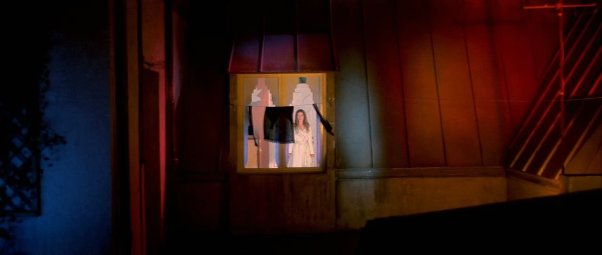
An even more impressive manipulation of mise-en-scène lies in the film's door handles, another possible shout-out to Secret Beyond the Door: In their higher than usual positions, the handles emphasize the youth and stature of the film's characters in relation to their grotesquely imposing doll house. Suzy returns to the school, meeting the faculty and her fellow students. With the exception of Sara (Stefania Casini), all the girls are petty and cruel. The administrators—the miserly Madame Blanc (Bennett) and the firm Miss Tanner (Alida Valli)—are cold and suspiciously secretive.
Just as Madame Blanc and Miss Tanner are the picture-perfect renditions of evil stepmothers, the school's attendees bring to mind Cinderella's bitchy stepsisters. Madame Blanc, like Snow White's jealous stepmother, is instantly aware (and wary) of Suzy's beauty: "You're pretty, very pretty indeed." More importantly, though, is the element of distance from family—Suzy's journey is similar to that of Snow White's in that both heroines left the comfort of home for the misleading solace of a dwelling in the woods. Suzy is forced to stay at the Academy after a mysterious fainting spell; like Snow White's poisoned apple, wine has been used to keep Suzy close to the enemy.
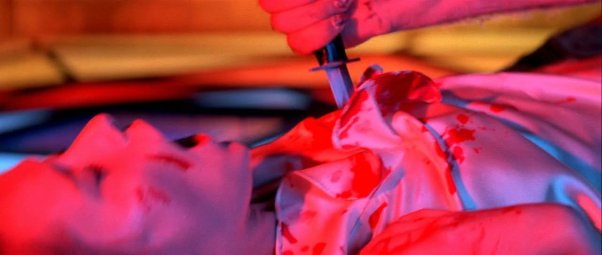
Argento wallows in all sorts of weird behavior when the gossipy Olga goes on about the snake-like nature of girls whose names begin with the letter "S" while another student poetically pontificates about school procedures: "Squawk, squawk, squawk. Mata Hari is gong to make her daily report." Even the words in the film are like seductions. The wallpaper in Pat's bedroom is also Argento's first allusion to flying in the film. Supernatural behavior in Suspiria is pervasive and inescapable, commanded by a coven of witches.
Even a simple swim is seemingly chaperoned by a faceless evil. It is this otherworldly presence that perhaps explains why the rationale for death in the film remains so inexplicable: the school's blind piano instructor, Daniel (Flavio Bucci), is mauled to death by his own guide dog; and earlier in the film, Daniel is unceremoniously fired from the school after his dog is accused of taking a bite out of Madame Blanc's young, blond-haired nephew. Whether the dog intentionally attacked the child is beside the point, the animal is clearly commanded by a supernatural being when it lunges for his own master. In this, the film's signature set piece, Tovoli's camera takes on the point of view of a flying monster. Walking through a desolate Munich plaza, the helpless blind man senses evil. Shadowy figures hovering above the plaza's main building become the sole means by which the spectator can gauge the shape of this evil. Later in the film, a bat attacks Suzy in her bathroom. The animal seems to function as bait, convincing Suzy to explore the cavernous hallways of the schoolhouse.
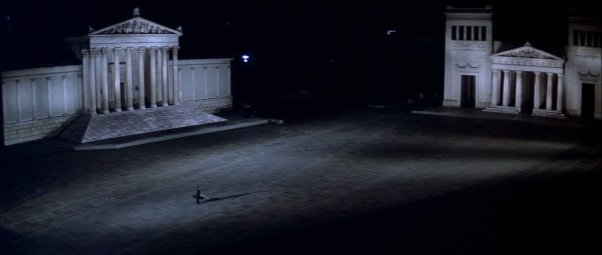
The safety of the Freiburg airport gives way to the psychedelic terror of the Academy, where Suzy has been propelled into Alice's terrifyingly colorful rabbit hole. The film's visual palette is suggestive of a hierarchical journey through the Academy. Hallways are bathed in reds, yellows, and blues, and, in effect, different rooms in the school begin to take on a meaning all their own. Suzy meets the administrators in the garish Blue Room, where a grandiose staircase comes with a handrail made of golden snakes; Miss Tanner conducts her classes in the Red Room, where Suzy defends her right to live outside the school; and in the Yellow Room, her fainting spell gives way to a ravishing nosebleed. Journeying through the school's hallways, a poisoned Suzy seems frozen in time; she's overwhelmed by air-born dust particles and blinded by the light reflected off a star-shaped object being cleaned off by the school's kitchen woman. Every single image is ravishingly beautiful, like watching Secret Beyond the Door in Technicolor!
Traps have been set for those who should near or stumble upon the school's hidden passages—a nosy Sara meets her Grimm demise inside a room inundated with barbed wire. After her friend's demise, Suzy is forced to crack the code of the "secret/irises," imprinted on the walls of Madame Blanc's flowery chamber room and readily available to Suzy (not to mention the careful spectator) for deciphering. Once Suzy has destroyed the coven of witches, walls begin to crumble and crack. Indeed, the intricacies of Argento's mise-en-scène are as beautiful to behold as they are devastating to see falling apart. Suzy fights for balance, walking through the jewel-toned hallways of the academy so carefree she resembles a skittish, liberated diva seeking refuge from the deep recesses of her own subconscious. Once skeptical, she is now the master of Argento's magical domain. Snow White has left the building.
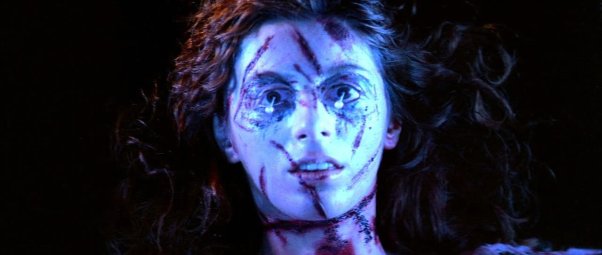
Technical Information:
Title: Suspiria
Year: 1977
Country: Italy
Director: Dario Argento
Source: Retail Blu-Ray
Video Codec: AVC H264
Container: .mkv
Size: 4.37 GB
Length: 1:38:17
Programs used: Unavailable
Resolution: 1280X544
Aspect Ratio: 2.35: 1
Video: Movie Only- AVC H264 @ 4372 kb/s
Frame Rate: 23.96 FPS
Audio: Italian DTS @ 1536 kbp/s
Subtitles: English- removeable
Ripper: Team CiNEFiLE
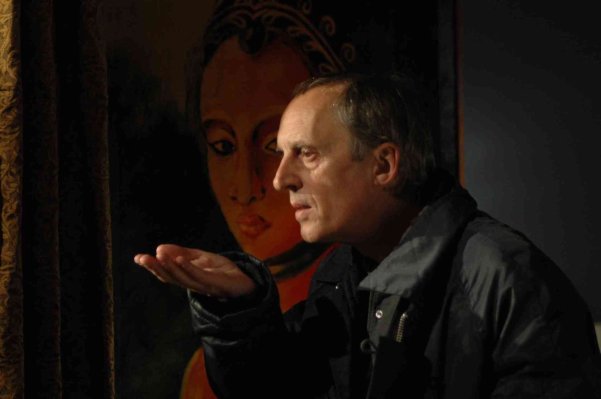
(Our prefered x264 player is Media Player Classic.)
(Use JDownloader to automate downloading)
Suspiria Megaupload Link


